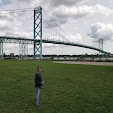It’s taken about 10 years to reach this
point, but the latest significant milestone in the replacement of the Wittpenn
Bridge in northern New Jersey was announced recently as the new Wittpenn Bridge
is now open to traffic.
Both the old and new bridges span the
Hackensack River near Jersey City, NJ in a heavily industrialized and heavily
trafficked area in the New York metropolitan area. The bridges are located
about three miles west of the Hoboken portal of the Holland Tunnel and this
area has long been seen as an important crossroads point for both road &
rail traffic in and around the region. The original highway bridge at this site
was built in 1930 and featured a central vertical lift span along with a narrow
four-lane roadway that may have been considered “modern” by Great
Depression-era standards, but was vastly inadequate by the standards of today.
The general substandard nature of the old bridge, plus the operational
challenges of having to raise the bridge upwards of 80 times a year to accommodate
marine traffic on the Hackensack (and the monumental traffic delays that would
often be a result) forced New Jersey officials to consider replacing the bridge
with a new span capable of better meeting the demands of both road & river
traffic while providing more convenient connections on both approaches to other
major highway links in the area. In fact, discussions on this subject had taken
place as far back as the 1970s; repair/rehab contracts issued/executed in the
early 1990s were originally meant to serve as a temporary solution until the
bridge could be replaced entirely.
Ground was finally broken on the
replacement bridge project in 2011 and has generally progressed at a snail’s
pace for most of its life, due in large part to challenges related to the project’s
location and funding. (The total price tag for the project is expected to come
in at over $500 million.) The new bridge stands 70 ft above river level in the
closed position, as opposed to the 35 ft above river level of its predecessor;
this means that the new bridge will not have to be raised nearly as many times per
year, which will generally improve the flow of traffic in the area. Its deck is
also far wider than its predecessor and is wide enough to carry six travel
lanes, plus full-width shoulders and dedicated pedestrian/cyclist space as part
of the East Coast Greenway trail. While appearing to be very ordinary from a
distance, this new bridge’s increased operational capacity and improved safety
features represent a giant step in the right direction over what was in place
previously.
The new bridge began carrying traffic on October 1, 2021 after nearly a decade of construction; work will continue on site for the next two years in the form of demolishing the old bridge and completing additional ramp connections on both approaches. It’s a project that has been talked about and built slowly over the last few decades, but this milestone of transferring traffic along Route 7 to a modern structure has been reached at last.
This bridge and its predecessor are named
for Henry Otto Wittpenn, a former mayor of Jersey City, NJ (1908-1913), who
also served as a State Highway Commissioner and member of the New Jersey State
Highway Commission (a precursor of today’s New Jersey Department of Transportation
– NJDOT). Wittpenn also ran unsuccessfully for Governor of New Jersey in 1916
while serving simultaneously as a Civilian Overseer of the Port of New York, a
position he was appointed to by President Woodrow Wilson. Wittpenn’s name has
been attached to the highway bridge(s) at this location ever since his death in 1931.

As the new Wittpenn Bridge (far right) begins to carry traffic, the old bridge (center) has been retired and demolition work has commenced. Immediately south of the old bridge are two railroad bridges built at approximately the same time - the Harsimus Branch Bridge and the PATH Bridge.














Comments